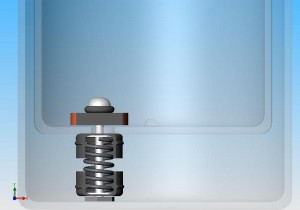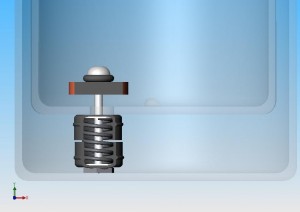Designer: Vidya Goli
INTRODUCTION
The client had a traumatic brain injury at a young age. As a result, she occasionally develops high muscle tone. When this occurs while she is drinking, she cannot stop taking in fluid and she chokes. Currently, a caregiver needs to monitor the client closely, and squeeze the straw if necessary to prevent choking. The goal of this project was to build a flow-controlled sports bottle that limits the amount of fluid that the user can drink at one time. This will prevent choking and give the client more independence when drinking fluids.
The design used a two cup system, in which one cup fits inside the other. A caregiver fills the inner cup with fluid, and the client can dispense a small amount of fluid into an outer cup. The client then drinks from the outer cup through a straw. After drinking, they can then dispense more fluid from the inner cup into the outer cup. This limits the amount of fluid that they can drink at one time.
SUMMARY OF IMPACT
The flow-controlled sports bottle will have a large impact on the client’s independence. While using a regular bottle and straw, the client would require assistance in pinching her straw to prevent excess fluid intake and choking. With this sports bottle, she will not require assistance if she develops high esophageal tone. The flow-controlled sports bottle will help her to drink without fear of choking. The client’s mother commented the bottle “works great” and it was easy for the client to use.
TECHNICAL DESCRIPTION
The device uses a two-container design in which the client releases fluid from an inner storage bottle, through a valve, into an outer drinking container. The design uses the Nalgene GoCup™, which consists of a Lexan® polycarbonate sports bottle that snaps into a Lexan® outer measuring cup. When the user presses down on the sports bottle, the fluid flows from the inner bottle through a valve into the outer cup. The user then drinks from a straw that is placed in the outer cup. The Lexan® is durable and temperature resistant from -135o C to 135o C. The bottom diameter of the outer cup is 6.0 cm, allowing it to fit easily into cup holders of 6.5 cm diameter.
The bottle design allows the client to easily refill the inner bottle. To activate flow release, the client simply places her hand above the bottle and presses the bottle downward. The flow rate from the inner bottle into the outer cup is 5.0 ml./sec when the bottle is half-full (240 ml or 8 oz). When the client stops pressing, the bottle springs back up and the valve closes. If the inner bottle is half-full, then up to 110 ml or 3.7 oz can be dispensed into the outer cup. However, the straw doesn’t reach the bottom, so the maximum fluid that the client can drink is about 2.7 oz.
The valve consists of all commercial parts found in the faucet repair section of a hardware store, so it is non-toxic. A nylon screw is placed through a hole in the bottom of the inner bottle. An o-ring and gasket is mounted below the head of the screw to seal the hole from above. Below the hole are gaskets, a spring, and a nut (see figure 2A). The force of the spring causes the hole to be blocked under normal conditions. When the client presses down on the inner cup, the spring is compressed, opening up the hole and letting fluid flow into the outer cup (see figure 2B).
There is a second hole in the bottom of the inner cup to provide an opening for the straw to reach the outer cup. A silicone gasket is used (taken from a child’s spill-proof cup) around the straw to prevent fluid from leaking through that hole.
The total cost of the device is about $35.






One Comment
Hi,
Back in 2003, I suffered a Traumatic Brain Injury. I use to have that exact issue. I was on a puray diet and had to drink thicken liquids. I still suffer from right side hemiparisis and I have a speech impairment. But after suffering my injury I made slow progress and earned my Associate degree in Architectural technology. Then earned my BA in architecture in ’12. One note, it’s not called choking for head injury patients, instead, because her fine motor skills are impaired its called aspirating. Can cause gnemania and eventually death. Great invention